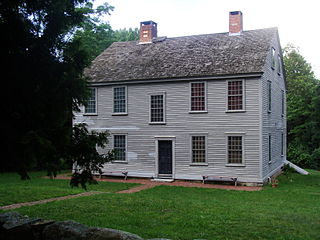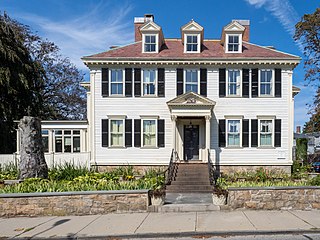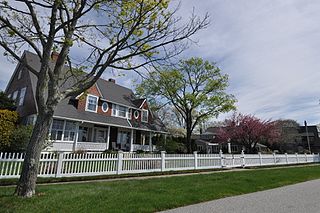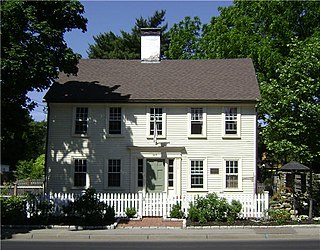
West Warwick is a town in Kent County, Rhode Island, United States. The population was 31,012 at the 2020 census.

The General Nathanael Greene Homestead, also known as Spell Hall, is a historic house at 20 Taft Street in Coventry, Rhode Island. It was the home of American Revolutionary War general Nathanael Greene from 1770 to 1776, and was owned afterwards by his brother Jacob Greene and his wife Margaret. The house is owned and operated by the General Nathanael Greene Homestead Association, a non-profit organization, and was opened as a museum in 1924.

The John Tillinghast House is an historic colonial house in Newport, Rhode Island. It is a 2+1⁄2-story wood-frame structure, built in 1760 for John Tillinghast, a wealthy merchant. A high-quality example of academic Georgian architecture, the house was a home for a number of notable people during and after the American Revolutionary War. It was probably occupied by the Marquis de Chastellux, an engineer in the French Army while he was stationed in Newport, and by General Nathanael Greene, who hosted George Washington and the Marquis de Lafayette on a visit to Newport. From 1821 to 1824 it was home to William C. Gibbs while he was Governor of Rhode Island.

The Benjamin F. Greene House is an historic house at 85 Cross Street in Central Falls, Rhode Island, USA. The Second Empire house was designed by Clifton A. Hall and built by Wheeler & Marchant in 1868. The house is one of a small number of high-style mid-19th century houses in the city. It was built for Benjamin Franklin Greene, a second-generation mill owner in the Central Falls/Pawtucket area.

The Armory of the Kentish Guards is a historic armory at Armory and Peirce Streets in East Greenwich, Rhode Island and is currently home to the Kentish Guards, a historic Rhode Island Independent Military Organization.

Buttonwood Beach Historic District is a historic district bounded by Brush Neck Cove, Greenwich Bay, Cooper and Promenade Avenues in Warwick, Rhode Island. Buttonwood Beach is a bucolic neighborhood on the eastern limb of the Nausauket neck, located in the West Bay area of Warwick, Rhode Island. Buttonwoods is delimited by Nausauket and Apponaug to the west, Buttonwoods Cove to the north, Greenwich Bay to the south and Oakland Beach to the east. Buttonwood Beach was founded as a summer colony in 1871 by the Rev. Moses Bixby of Providence's Cranston Street Baptist Church, who was looking for a place to establish a summer colony by the shore for his congregation. He envisioned a community that would be similar to Oak Bluffs on Martha's Vineyard, where the Methodists established a summer campground in 1835. Today, this coastal neighborhood on Greenwich Bay is home to people from many different religious backgrounds.

The Cowesett Pound is an historic animal pound on Cowesett Road in Warwick, Rhode Island. The pound, a roughly square structure built of unmortarted fieldstone four to five feet in height, is estimated to have been built in 1742 by David Greene, although there was an older pound already at the site. Its walls were probably once topped by capstones, but only one of these survives. The entrance to the pound has a wooden gate added during a 20th-century restoration.

Forge Farm is an historic farm in Warwick, Rhode Island. Established in the mid-17th century by the Greene family, it is one of the oldest farms in Rhode Island. It was the birthplace of General Nathanael Greene, a prominent American general in the American Revolutionary War. The core of the main house was built in 1684 by James Greene, son of John Greene, who purchased the land from local Native Americans. It has been extended and altered numerous times in the 18th and 19th centuries. Nathanael Greene was born in this house in 1742, and the farm was owned for many years by Nathanael's brother Christopher, and wife, Deborah (Ward) Greene, daughter of Continental Congress member Samuel Ward.

The Forge Road Historic District is a historic district on Forge Road from Ives Road to the Potowomut River in Warwick, Rhode Island. Most of the district's nearly 200 acres (81 ha) are taken up by the Forge Farm, which lies south of Forge Road, is one of the oldest farms in Rhode Island, and was the birthplace of American Revolutionary War general Nathanael Greene. A memorial to Greene stands near the bridge crossing the Potowomut River. Opposite the farm on Forge Road stand four houses, all of which date to the late 18th to mid-19th century.

The Caleb Gorton House is a historic 18th-century house located in Warwick, Rhode Island.

The Moses Greene House is an historic house in Warwick, Rhode Island. It is a 2+1⁄2-story wood-frame house with a large central chimney, and a rear ell. The main block was built c. 1750, and is one of Warwick's few surviving 18th-century houses. It is located on one of the first sites to be occupied by European settlers in Warwick, near one of its first sawmills. In 1750, Moses Greene built his home where Buckeye Brook meets Mill Cove. The home may have served a role in the Underground Railroad—a secret cellar room is accessed by a stone wall that slides aside on iron tracks. The room may have also been used by rum smugglers. The house was listed on the National Register of Historic Places in 1983.

The Peter Greene House is a historic house in Warwick, Rhode Island. The 2+1⁄2-story wood-frame house was built c. 1751, probably by the sons of a militia captain named Peter Greene, and is a rare surviving 18th-century house in Warwick. It has a five-bay facade with a plain door surround, a central chimney, and a rear ell.

The Richard Wickes Greene House is an historic house in Warwick, Rhode Island. The 2+1⁄2-story wood-frame house was built in 1849, and is an excellent local example of Georgian style. Richard Wickes Greene was a ship's captain who acquired the property from the Wickes family in 1826.

The Green–Bowen House is a historic house at 100 Mill Wheel Road in Warwick, Rhode Island, United States. It is a late-date stone-ender house, built c. 1715, and is the oldest surviving house of the locally historically prominent Greene family. It stands on land purchased by John Greene from local Native Americans in 1642, and was probably built by Fones Greene not long after he acquired the land in this area in the early 18th century. The house has a two-story main block, with two rooms on each floor, and its west wall and chimney are built of brick instead of stone. Shed-roof additions dating to 18th century were added abutting the west side and the rear. The property it stands on includes a 20th-century house, and a 19th-century barn and cottage.

The Greene–Durfee House is a historic house at 1272 West Shore Road in Warwick, Rhode Island. The house, a 2+1⁄2-story wood-frame structure with a large central chimney, stands set well back from the west side of the road, opposite Church Avenue and a small cemetery. It is set behind a small wood-frame commercial building and is partially screened from view by bushes. Built c. 1780, it is one of the city's finest Georgian style houses, with a particularly well-preserved interior.

The John R. Waterman House is an historic house at 100 Old Homestead Road in Warwick, Rhode Island. The 2+1⁄2-story wood-frame house was built c. 1800 by John R. Waterman, a prominent local farmer and politician. Waterman played a significant role in what became known as Dorr's Rebellion, an ultimately successful attempt to force liberalizing changes to the state constitution. The house is an excellent local example of Federal style, and is locally distinct for its use of paired interior chimneys instead of a large central one.

The Valley Queen Mill is an historic mill at 200 Providence Street in West Warwick, Rhode Island.
Greene House may refer to:

John Holden Greene (1777-1850) was a noted early nineteenth century architect practicing in Providence, Rhode Island. The bulk of his work dates to the late Federal period, and is mostly in the architectural style of the same name. Greene is responsible for the design of over fifty buildings built in the city between 1806 and 1830, almost half of which are still standing.

William Greene Jr. was the second governor of the state of Rhode Island, serving in this capacity for eight years, five of which were during the American Revolutionary War. From a prominent Rhode Island family, his father, William Greene Sr., had served 11 terms as a colonial governor of Rhode Island. His great-grandfather, John Greene Jr. served for ten years as deputy governor of the colony, and his great-great-grandfather, John Greene Sr. was a founding settler of both Providence and Warwick.





















